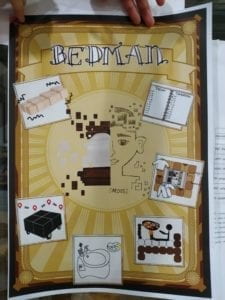Based on my understanding, interaction is a conversation happening between two or more objects, through which they negotiate in order to give outcomes. As I am browsing the website http://www.creativeapplications.net/ , a design called 100% chair arouses my interest. The designing team builds up different chairs with leftover offcuts. The A.I. is going to predict the possibility of the chair emerging in the near future. I like this idea a lot and consider it highly interactive. It looks like there is a conversation between the A.I. and the team. The team has to make a chair according to their own imagination, and present it to the A.I., which analyzes the possibility of emergence using the database. The outcome, as the introduction of this project suggests, represents how the A.I. views this world. This design deepened my understanding of interaction. The outcome from this design is unpredictable and cannot be controlled. Both the team and the A.I. contributes to the outcome. What’s more, the number it gives, from 0% to 100%, shows the attempt of people trying to explore the field of A.I. in the human perspective instead of the technology perspective. It inspires me with the idea that interaction is more a process of creating and exploring with no definite end than a well-designed program with limited outputs. On the other hand, another designing of a smart-home counterspy agent on the same website is thought-provoking in the opposite way. As described in the introduction of this designing, this machine allows you to know whether your home devices send out private information illegally. Once suspicious activities are detected, you are then able to send a request for explanation via this machine. This, indeed, is a great idea of protecting personal privacy. The designing suggests convenience as well. However, I found it may not apply to interactive designing that much. It is sort of similar to the 100% chair idea, utilizing collection and analyzes of data. But it shows no active interaction between objects. It is more like a helpful and objective tool. People can read the signs about all the devices in their home, but what they can do as interacting with this smart-home agent is just to choose whether to press the button of sending the request. After comparing my feeling over these two designing, I develop my definition over interaction. The 100% chair project better aligns with my definition. It perfectly displays the conversation happening between the A.I. and human beings. Through collaborative exploration, certain outcome is produced.
My idea of describing interaction in term of communication derives from Introduction to Physical Computing by Igoe and O’sullivan. As they point out, the way people interact with their computers is highly restricted. People can only look at the screen and type on the keyboard. Therefore, from the view of computers, people are monsters made up of two eyes and ten fingers. This set limits on how people express themselves to the computers, which also set barriers to better interaction. To develop communications of a higher level, more human senses have to get involved. The communication, therefore, becomes more complex but contributes to more humanity in the outcome.
Now I am going to turn to the idea of “Bedman” in my group project. My group members (Amily Yang, Gloria Liu, Molly He and Ning Zhou) and I meant to come up with the prototype of a product in people’s daily life in 2119. We turned a bed into a combination of an alarm clock, an automatic kitchen, a basin and a vehicle with an artificial intelligence. To allow so many functions on a single product, we had to add flexibility to the bed. As we imagined, the bed consisted of several cubes of different sizes. They were independent from each other and free to move automatically in order to cater to the function. Some of the cubes were responsible for adjusting the appearance of the bed so that it could better function, while the others (the bigger ones) had the additional ability of storage. Made up of these cubes, the bed can offer both comfort and convenience. However, if our designing was just about imagining a versatile bed, the bed would remain to be a helpful but mechanic tool without any form of interaction. To apply our definitions of interaction to the designing, we decided to add a personality to the bed, allowing it to run conversations with its owners. Specifically, the owner could upload his/her schedule for the other day orally to the A.I. such as jogging at 6AM, taking a shower at 7AM and having breakfast at 8AM. Then, the A.I. would remind its owner of this schedule. What made it special was that the schedule could not be canceled easily without proper reason. After the schedule was uploaded, it would be analyzed by the A.I. immediately to assess the importance of each item. For instance, since jogging was a healthy option, the A.I. would insist on persuading its owner to finish this task. Even though the owner might want to cancel it for lack of motivation in the morning, the A.I. listed suggestive data and used encouraging language to persuade him/her. Only after negotiation or repletion of the command could this item be canceled, which meant the owner still had the right to choose. All in all, the bed collected its owner’s personal data, analyzed his/her living habits and gave persuasive advice of a healthier life. It would neither do what it was asked to (for example, cancel the morning jogging) immediately if the command deviated from the owner’s previous goals, nor become to forceful to push the owner to complete his/her tasks. It operated communications with its owner, aiming to achieve a better life of its owner through negotiation and collaboration.

(We combine the skateboards with the boxes to represent the vehicle)

(The overall look of our “bed”)

(Our poster showing all the functions of the “bedman”)
I think the interaction displayed by our designing aligns with my definition of it. the “bedman” allows conversation between its owner and the embedded A.I. system, through which they reached a balance of the attempt to live a healthier and better life and the freedom of making choices. As the two projects above suggest, interaction should be a both-sided activity. In the case of our “bedman” project, both the bed and its owner actively engage in the interaction by listening to each other, processing each other’s ideas and stating their own words.